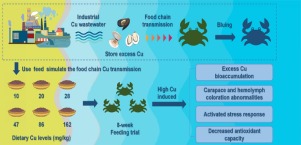当前位置:
X-MOL 学术
›
J. Hazard. Mater.
›
论文详情
Our official English website, www.x-mol.net, welcomes your feedback! (Note: you will need to create a separate account there.)
Toxicological mechanism of excessive copper supplementation: Effects on coloration, copper bioaccumulation and oxidation resistance in mud crab Scylla paramamosain.
Journal of Hazardous Materials ( IF 13.6 ) Pub Date : 2020-04-02 , DOI: 10.1016/j.jhazmat.2020.122600 Jiaxiang Luo 1 , Tingting Zhu 1 , Xuexi Wang 1 , Xin Cheng 1 , Ye Yuan 1 , Min Jin 1 , Mónica B Betancor 2 , Douglas R Tocher 2 , Qicun Zhou 1
Journal of Hazardous Materials ( IF 13.6 ) Pub Date : 2020-04-02 , DOI: 10.1016/j.jhazmat.2020.122600 Jiaxiang Luo 1 , Tingting Zhu 1 , Xuexi Wang 1 , Xin Cheng 1 , Ye Yuan 1 , Min Jin 1 , Mónica B Betancor 2 , Douglas R Tocher 2 , Qicun Zhou 1
Affiliation

|
Copper is a widespread pollutant in marine environments, and marine animals can ingest large amounts of copper through the food chain. Here, an 8-week feeding trial was designed to investigate the effects of different dietary copper levels on coloration, copper bioaccumulation, stress response and oxidation resistance of juvenile mud crab Scylla paramamosain. The results indicated that crabs fed the diet with 162 mg/kg copper exhibited a dark-blue carapace and hemolymph. The accumulation of copper in tissues was positively correlated with the level of copper in feed. High/excess dietary copper (162 mg/kg) up-regulated the expression of stress response related genes, and reduced the expression/activities of anti-oxidation genes/enzymes. The activity of phenoloxidase decreased significantly when dietary copper level was 86-162 mg/kg, and the expression of hemocyanin was up-regulated in crab fed the diets with 28-162 mg/kg copper. Overall, the results of the present study indicated that high dietary copper led to parachrea in carapace and hemolymph of mud crab, and caused copper deposition abnormality in carapace and hepatopancreas. The data suggested that the toxic effects of dietary copper were concentration-dependent such that, excess dietary copper (162 mg/kg) had adverse impacts on oxidation resistance.
中文翻译:

过量补铜的毒理学机制:对青蟹青蟹着色、铜生物富集和抗氧化性的影响。
铜是海洋环境中广泛存在的污染物,海洋动物可以通过食物链摄取大量铜。在这里,设计了一项为期 8 周的喂养试验,以研究不同日粮铜含量对青蟹青蟹幼鱼的着色、铜生物蓄积、应激反应和抗氧化性的影响。结果表明,用 162 mg/kg 铜喂养的螃蟹表现出深蓝色的甲壳和血淋巴。组织中铜的积累与饲料中铜的含量呈正相关。高/过量的膳食铜(162 mg/kg)上调应激反应相关基因的表达,并降低抗氧化基因/酶的表达/活性。当日粮铜水平为 86-162 mg/kg 时,酚氧化酶活性显着下降,28-162 mg/kg铜饲料的螃蟹血蓝蛋白表达上调。总体而言,本研究结果表明,高膳食铜导致青蟹甲壳和血淋巴出现副壳,并导致甲壳和肝胰腺中铜沉积异常。数据表明,膳食铜的毒性作用与浓度有关,因此过量的膳食铜(162 mg/kg)会对抗氧化性产生不利影响。
更新日期:2020-04-03
中文翻译:

过量补铜的毒理学机制:对青蟹青蟹着色、铜生物富集和抗氧化性的影响。
铜是海洋环境中广泛存在的污染物,海洋动物可以通过食物链摄取大量铜。在这里,设计了一项为期 8 周的喂养试验,以研究不同日粮铜含量对青蟹青蟹幼鱼的着色、铜生物蓄积、应激反应和抗氧化性的影响。结果表明,用 162 mg/kg 铜喂养的螃蟹表现出深蓝色的甲壳和血淋巴。组织中铜的积累与饲料中铜的含量呈正相关。高/过量的膳食铜(162 mg/kg)上调应激反应相关基因的表达,并降低抗氧化基因/酶的表达/活性。当日粮铜水平为 86-162 mg/kg 时,酚氧化酶活性显着下降,28-162 mg/kg铜饲料的螃蟹血蓝蛋白表达上调。总体而言,本研究结果表明,高膳食铜导致青蟹甲壳和血淋巴出现副壳,并导致甲壳和肝胰腺中铜沉积异常。数据表明,膳食铜的毒性作用与浓度有关,因此过量的膳食铜(162 mg/kg)会对抗氧化性产生不利影响。


























 京公网安备 11010802027423号
京公网安备 11010802027423号